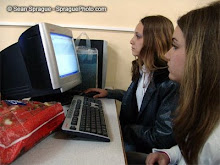http://alasmedia.wikispaces.com/TCEA_Practical+Movie+Making
Coverage
It's important to get a variety of shots when documenting. Coverage shots are composed of wide, medium, and close up shots. Wide shots establish location, medium or mid shots are used to show action, and close ups or tight shots are used to show emotions. Go to this link for an example: http://gallery.mac.com/flickschool#100024/ Close_Medium_Wide&bgcolor=black a
A-roll & B-roll
A-roll refers to footage where there's a talking head, like a person being interviewed. B-roll is secondary footage. This is usually video or photos that show what the person is talking about. Go to this link for an example: http://gallery.mac.com/flickschool#100024/ Leandro&bgcolor=black
Rule of Thirds
Most cameras come with an option of showing a grid (rule of thirds) that makes it easier to make sure you get your composition right. What is the rule of thirds? Two equally spaced horizontal lines that are intersected by two vertical lines. You want to make sure to place your subject where the lines intersect. The top horizontal line is also known as the eye line. When interviewing someone, this is how your composition should look.
Interviewing Tips
Picking an Interview Location
If you can, pick a place for the interviews. Make sure it's a place where you can control the light and minimize external audio. Hallways with students walking in the background might seem like a good idea, but keep in mind that they will be noisy. Be conscious of where you shoot, paying particular attention to light and sound.
Varied Conversation Poses
If you're filming in the same place for several interviews, switch up your poses! Place your interviewee to the right or left of the frame and go switching it up. If you can, change the background. Try different colored walls to switch up your backgrounds; this will make it look like you had a variety of shooting locations.
Eye line
When filming, you want to make sure that the interviewer is as close to the camera as possible. The only people who look comfortable staring straight into a camera are, you guessed it, news anchors. For the rest of us, it's easier to feel that you're having a conversation with someone. So by placing the interviewer as close to the camera as possible, the interviewee's eyes will be pretty close to looking at the camera.Also, if your subject is on the left of your frame, you want their eyes looking to their right. If they're on the right of the frame, you want their eyes looking to their left.
Real World Example
A great example of this kind of work is what is done in The Office (the TV Show). They do a lot of "fly on the wall" documenting, but they have a special place for interviewsBTW: Check out their following of the rule-of-thirds, eye lines, and even lighting.
THE 5 P’S OF YOUR INTERVIEW
Don’t think you can just “wing it”. You can’t. You’ll look foolish and insult your guest by not respecting their story. Your first step in this process is to become organized.
Before you begin, get educated. Do some research. Find out what you can about this individuals background. Plan some open-ended questions. Think about the different camera angles you would like to use. What B-Role footage will you need? Where will you conduct the interview? What type of music will you want to incorporate?
Produce
Set up and shoot your interview as well as your B-roll.
Post
Edit your video, insert background music, insert B-roll. In short, make your video smart and professional
Present
Share your video with your class, your peers the world!
(Ph)Feedback
Get better at digital story telling by excepting helpful criticism.
MORE
Check out these sites to learn more about video story telling:
http://alasmedia.wikispaces.com/TCEA_Practical+Movie+Making
http://www.sfett.com/html_movie/Ican/4.html
http://cinedelagente.com/html/fs_lighttest.html
Check out these sites to see examples of student films:
http://cinedelagente.com/
http://www.sfett.com/html_movie/Ican/4.html
http://gallery.mac.com/flickschool#100102&view=grid&bgcolor=black&sel=1

